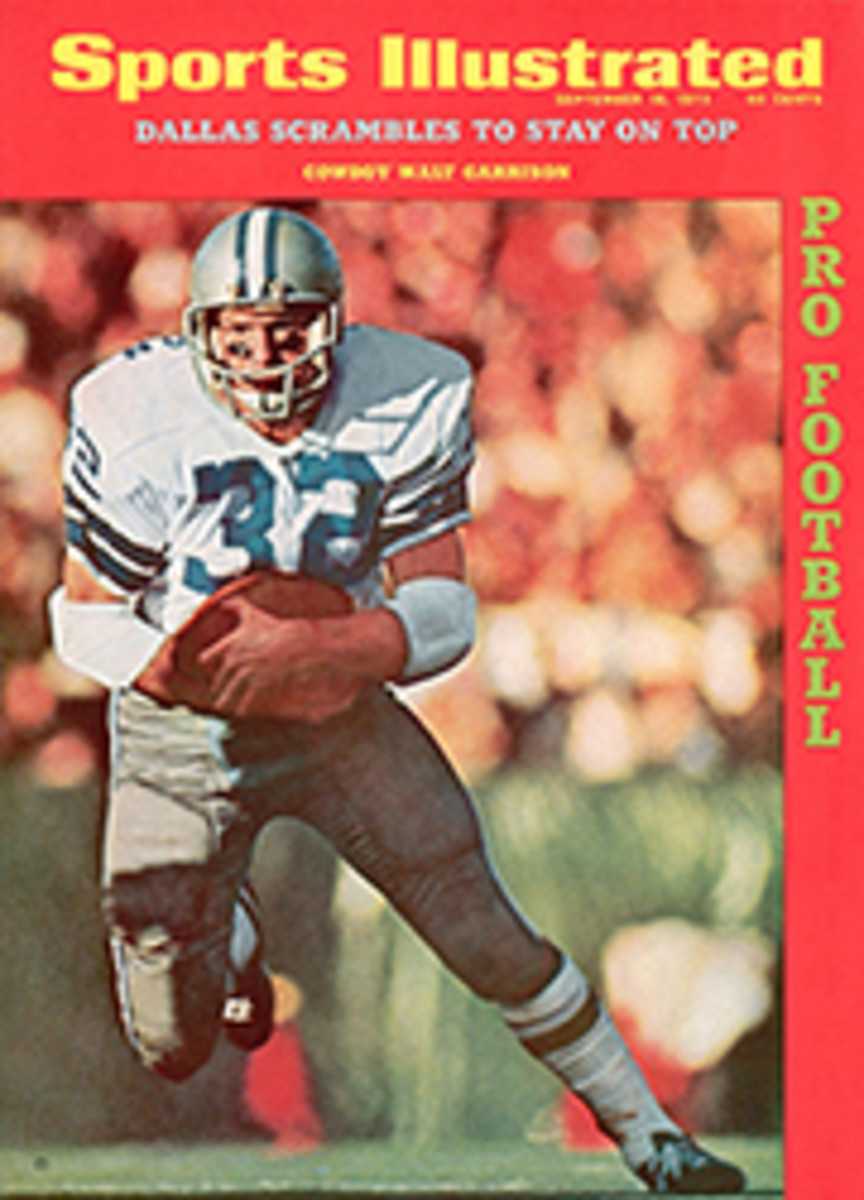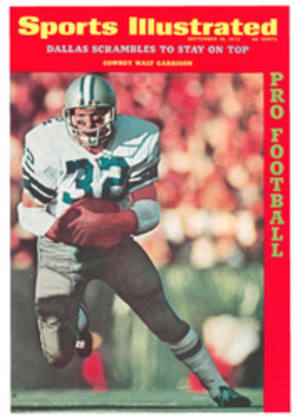
National East
"The quarterback is the most important man on the football team," said Dallas Cowboy President Tex Schramm. "You don't go anywhere without him." The comment would seem banal except that it occurred just two days after Roger Staubach's disastrous game of bump and run with the Rams' Marlin McKeever. Still, the Cowboys have Craig Morton, which leaves them about as well off as anyone else in the NFC East, where none of the five teams has completely resolved its quarterback situation.
As for Morton, he appears remarkably calm. "Why not?" he asks. "I took the Cowboys to the Super Bowl once before, and this team has always performed well for me." The rest of the Cowboys seem equally confident, but, just in case Morton runs to darkness, there is now Jack Concannon. Nor has anyone counted Staubach out. "What made him try to run over that guy is what will bring him back quick," says Coach Tom Landry.
The well-tempered unit that Landry and Schramm have molded seems capable of overcoming any loss—say, for instance, of the Cowboys' No. 1 rusher, and biggest headache, Duane Thomas, who was traded to San Diego for Running Back Mike Montgomery and Wide Receiver Billy Parks. That still leaves Walt Garrison (see cover) and brittle Calvin Hill, who can fill Thomas' shoes if he doesn't suffer another Great Toe Throb. Montgomery and Robert New-house, the No. 2 draft choice from Houston, also are ready, but with the Dallas offensive line bulging with All-Pros it doesn't much matter who carries. And with Bob Hayes, who says he is faster now than he was when he won two gold medals at the Tokyo Olympics, Lance Alworth, Ron Sellers and Parks, it doesn't much matter who throws the passes either.
The offense, however, may have to readjust some of its thinking. Dallas sends its backs out on most pass plays, putting added pressure on the line. Consequently, Cowboy quarterbacks get sacked plenty. Only six teams, none with a winning record, were worse at protecting the quarterback in 1970. Staubach's quickness helped improve that statistic a bit last year, but without him Dallas may have to become protection-conscious.
If the Cowboys have some offensive problems, their opponents have quite a few more. The Dallas Doomsday Defense returns, which means other teams still have to face up to Tackle Bob Lilly, not to mention the best linebacking in the conference. One wonders when age will start to be a factor. Lilly is 33, Chuck Howley 36 and five other defensive starters are over 30. Indeed, averaged up, the Cowboys' starting 22 is as old as, you guessed it, the Redskins. But no one in Dallas shows signs of slowing.
Washington has two candidates for the quarterback job, and both Billy Kilmer and Sonny Jurgensen (SI, Aug. 21) are making it perfectly clear that, as Redskin Coach George Allen will tell you—and tell you and tell you—experience counts. As long as Washington stays in contention for the playoffs, Kilmer will start, but Jurgensen's quick-striking ability makes the Redskin bench quite an asset.
Kilmer or Jurgensen can hand off to Larry Brown, as good as any in the league, or pass to the likes of Charley Taylor, Roy Jefferson and Jerry Smith, all ranked among the top 10 active receivers in football. Brown, who has had a tender knee, was held out for much of the exhibition season as a precaution, but George Nock, acquired in June from the Jets, and Bob Brunet spent that time proving that Brown needn't be used all the time anyway. Taylor is back after missing most of last season with an ankle fractured while scoring a touchdown against Kansas City. "Charley keeps the defenses loose, not only with his pass catching but also with his tremendous downfield blocking," says Assistant Coach Mike McCormack. "We were 5-0 when he got hurt, but after that a lot of teams played what amounted to a goal-line defense against us."
One drawback to Washington's offense is its weak-kneed line. Jim Snowden, the team's best lineman, has already succumbed to torn ligaments and, of the five expected to start, two will perform on previously unreliable legs.
Before George Allen arrived, the Redskin defense consisted of 40 points and a prayer. Last year it finished fourth in the NFL, giving up just 190 points, the first time since 1958 (and a 12-game schedule) that Washington has yielded fewer than 300. Age has become a factor here, although not on the defensive line where Verlon Biggs, Diron Talbert and Manny Sistrunk are under 30. It is the deep seven that verges on senility. The most crucial spots are Middle Linebacker Myron Pottios, 33, and Safety Richie Petitbon, 34, both of whom have to stretch their guile a long way to keep their positions. At safety Allen added depth by trading for Roosevelt Taylor of San Francisco. He is 34.
The Redskins' biggest asset came out of the league office. The schedule has Minnesota on the first Monday night, but George Allen has never, never lost an opening game. And there is Dallas twice, but the other eight opponents compiled a 38-69-5 record in 1971 and only one, Atlanta (7-6-1), had a winning record. The Cowboys could be playing catch-up all season, but that's bad? Allen teams have never, never won a playoff game.
Remember the Philadelphia Eagles grumbling when their new coach, Eddie Khayat, demanded haircuts? Well, they finished out the season 6-4-1 and went through training camp, on a United Methodist campus where no alcohol is allowed, confident they could continue where they left off. Pete Liske returns at quarterback, but Eagle fans, if not the Eagles, are looking to a rookie, No. 1 draft choice John Reaves of Florida, to complete the resurgence. Reaves is the one who, told that Concannon was going to the Cowboys, said, "I was hoping they'd get Liske."
The Eagles' real hopes lie in a young, aggressive defense that held 1971 opponents to 16 points a game over the last nine weeks. Free spirit Tim Rossovich is gone, but Steve Zabel, who will take over the middle linebacking spot, "won't let Tim be missed," or so says Defensive End Richard Harris. For himself, Harris says he "wants to be three or four times better," a comment which might cause astonishment among some offensive tackles. There is quality depth all along the defensive line, the linebackers play the run well (although sometimes at the expense of the pass), and the deep backs, particularly Safeties Bill Bradley and Leroy Keyes, are excellent. Still, the defense can't do it all; the Eagles need a running attack. For now, the only real offensive threats are some speedy wide receivers—Harold Jackson, Ben Hawkins and 6'8" Harold Carmichael—and Kicker Tom Dempsey, who led the league in field-goal percentage last year despite never trying from inside the 20.
By his own admission, second-year Coach Bob Hollway has his work cut out for him in St. Louis. He says the keys to winning are staying together and playing together, but after last season he traded for four new offensive weapons, ridding himself in the process of his two top rushers—MacArthur Lane and Cid Edwards—and his top receiver, John Gilliam. Hollway's intention is to put more variety into his offense. He has added versatile Halfback Donny Anderson and Quarterback Gary Cuozzo, who, though a weaker thrower than incumbent Jim Hart or rookie Tim Van Galder, is more capable of handling multiple offenses.
One bright spot could be the receiving, where Jackie Smith, the tight end on whom the Cardinal offense has relied so heavily in the past, is well again after missing the last five games of 1971 with knee surgery. The wide receivers will be Mel Gray, a 9.2 sprinter, and No. 1 draft choice Bobby Moore from Oregon. Asked if he preferred to catch a football or run with it, Moore replied, "I just like to touch it; I like to have it a lot."
St. Louis suffered through enough defensive injuries last year to demoralize any team. But even healthy, the Cardinals have problems. With Washington twice, Baltimore and Minnesota in their first five games, the new Cardinals will have a tough time getting off the ground.
In New York last year the fans used to say that the Giants had but three football players, Quarterback Fran Tarkenton, Defensive End Fred Dryer and Safety Spider Lockhart. Now only Lockhart is left and one has to wonder. The Giants did pick up All-Pro Wide Receiver Bob Grim and Quarterback Norm Snead for Tarkenton, but since New York was already relatively strong in the receiving department and since Coach Alex Webster says he made the trade with confidence that backup signal-caller Randy Johnson could start, the Giants would seem to have got nothing for something. As partial compensation, Halfback Ron Johnson, who suffered a year full of leg miseries last season, is back in his 1970 form when he scored 12 touchdowns and accounted for over 1,500 yards running and catching.
The Giant defense finished 21st in the league in 1971 and can only get worse without Dryer and Tackle Jim Kanicki, who suffered an Achilles' tear. That is unless Defensive Coordinator Jim Garrett's Rover defense comes through. The Rover hopes to take maximum advantage of the club's one seasoned lineman, Jack Gregory, who played out his option in Cleveland, but even Garrett is not predicting instant success: "Time and patience should be on a marquee above Yankee Stadium," says he. Spell that "Wait'll Next Year."
ILLUSTRATION
ARNOLD ROTH
Nobody loves you when your downs are out.
ILLUSTRATION
ARNOLD ROTH
The East is famous for displaying a sense of style—even while running way over you.

